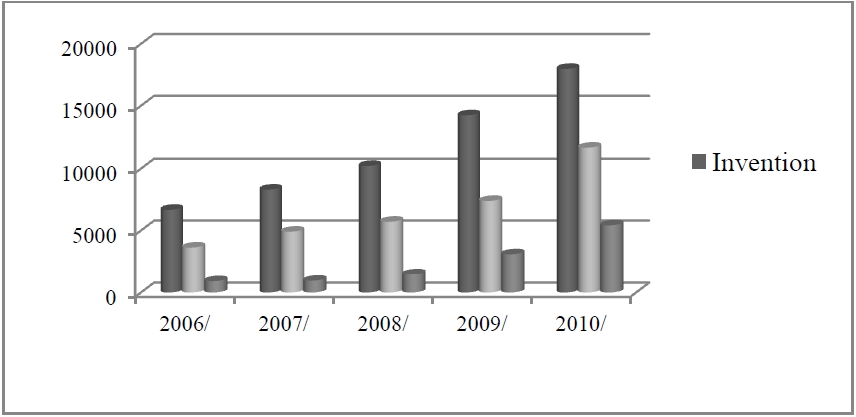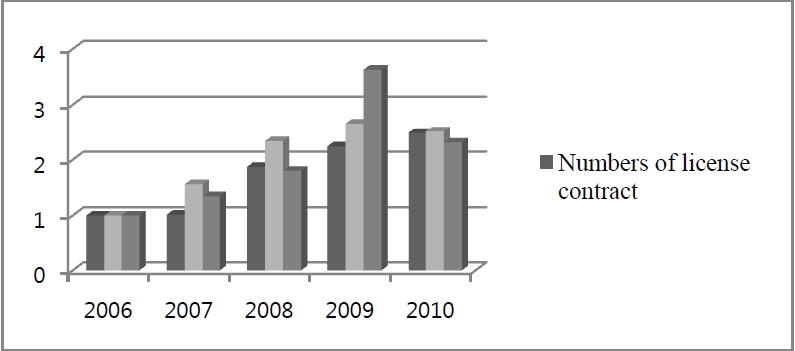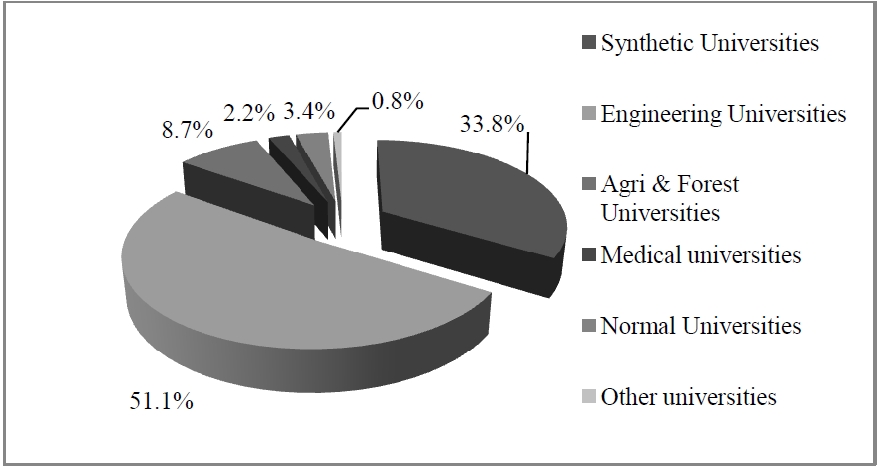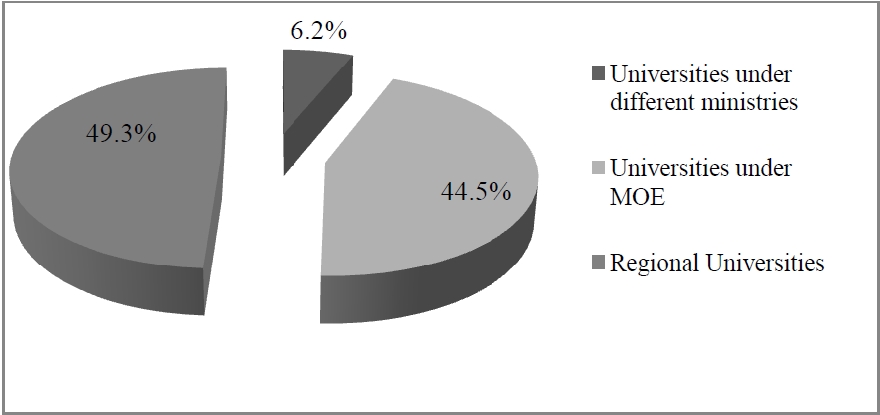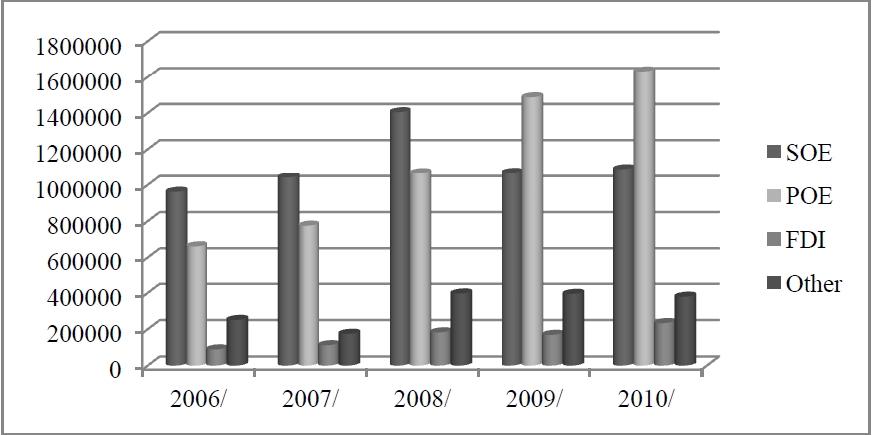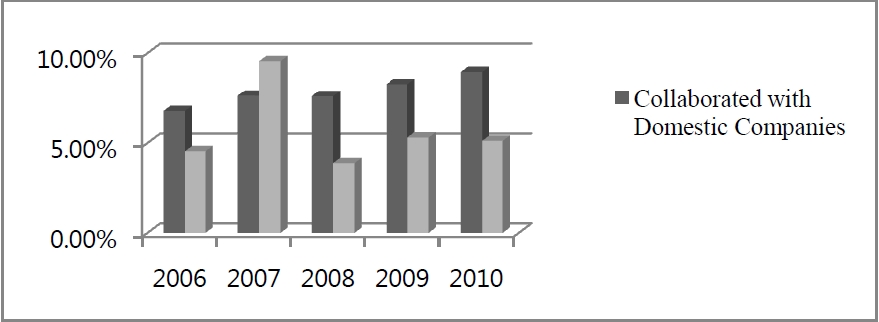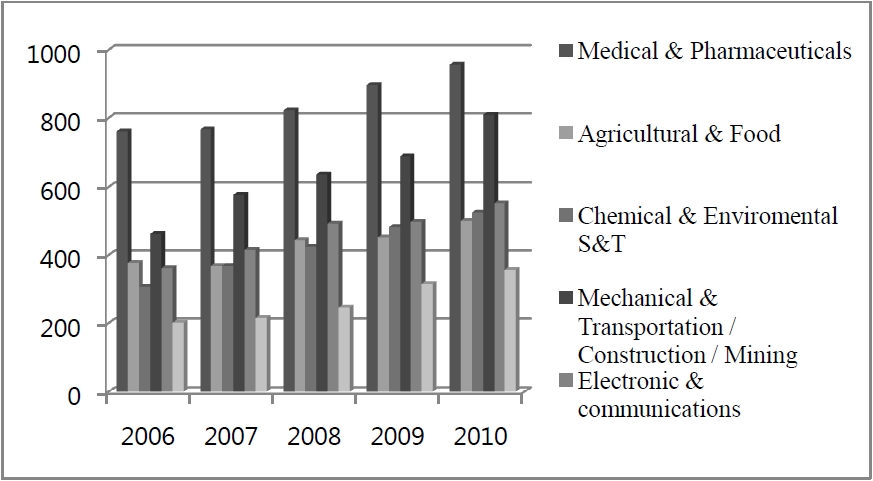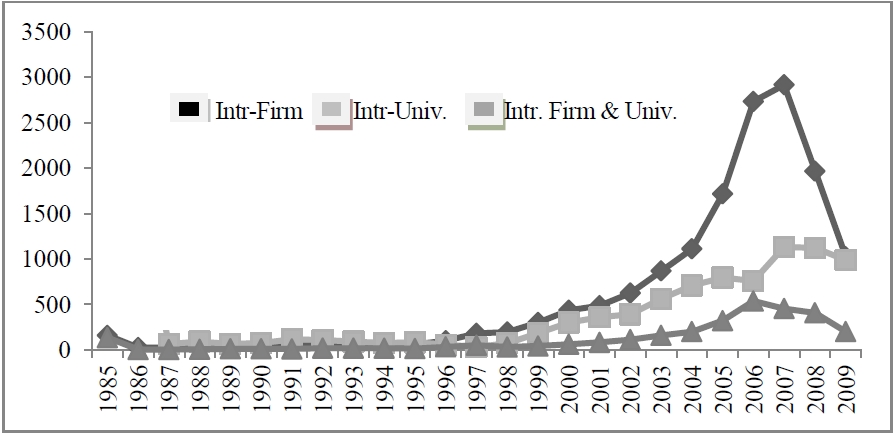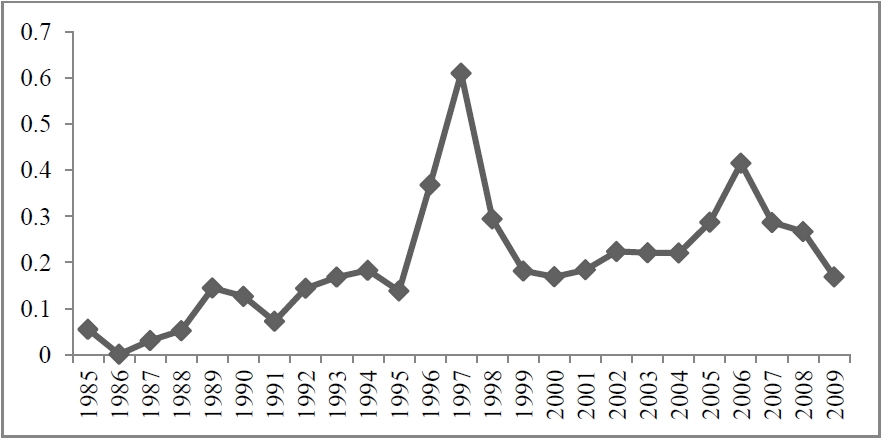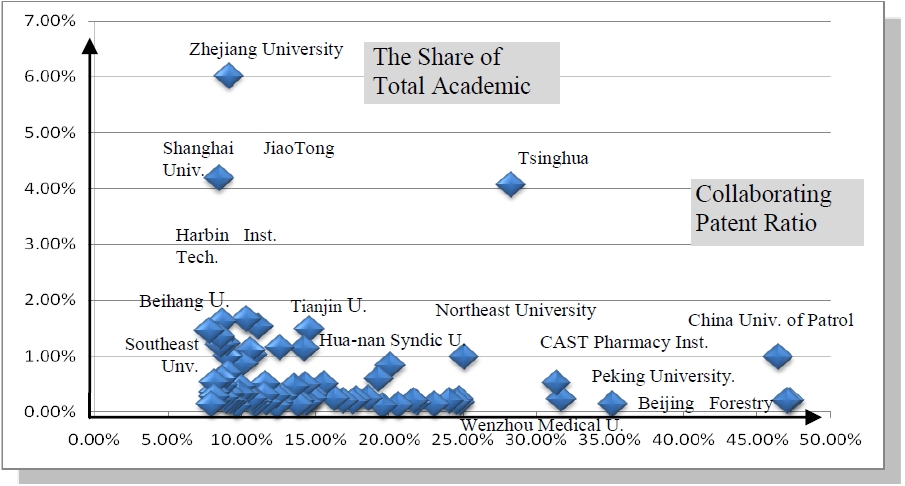



University-industry relationships are easily found in current universities throughout the globe, reflecting so-called science-based innovation or science-based industry. Then, are the patterns of this collaboration the same in all countries? Is the only difference found in the degree of development of each country? Aren’t there country-specific patterns? This paper is an answer to these theoretical questions. These questions will add a contribution to the theoretical discussion of entrepreneurial universities, of which the relationship is a main function.
One start to the discussion is the relationship in China, as it is not a natural phenomena developed by industries. Rather the relationship is motivated by government policy. In 1992, a policy oriented “University-Industry Alliances on Collaborative Development Engineering” was jointly initiated in China, by the former State National Economic and Trade Committee (the main body of current Ministry of Commerce and National Economic Development & Reform Committee), Ministry of Education of China (MOE), and the China Academy of Science (CAS). Policies for this relationship have been going since then, but we will discuss the relationship during the 10th 5-year Development Plan from 2006 to 2010 because of data.
We will discuss literature review in the second section. In the third section, three domains of the university-industry relationship are analyzed. In the fourth section, joint patenting is analyzed in depth. And in the last section, we will summarize the Chinese patterns of this relationship.
2. Literature Review on Unviersity-Industry Collaboration
The first academic revolution taking off in the late 19th century made research a university’s major function in addition to the traditional task of teaching. (Storr, 1952; Metzger, 1955; Veysey, 1965; Jencks and Reisman, 1968). The second academic revolution, integrating a mission for economic and social development, has been transforming the traditional teaching and academic university into an entrepreneurial university. The entrepreneurial university encompasses and extends the functions of the academic university, although, this academic entrepreneurship is sometimes challenged by arguments on possible deformation of the research university. (Slaughter and Leslie, 1997)
The 1950s, “Silicon Valley Model” at Stanford University provides an exciting example in promoting regional economic development by close cooperation between academia and industries. Etzkowitz and Leydesdorff (1995) first proposed the famous Triple-Helix notion, emphasizing that the interaction among university-industry-government (UIG) is the key to improve conditions for innovation in a knowledge-based society. In part because of influence from typical university revoluions, the linkage of academia, industry, and government have indeed been getting closer for innovation activities. In fact, the so called knowledge economy firstly appeared in the late 1980s, when scientific research was merged into an innovation system with an interdisciplinary nature, which in turn gradually formed a UIG based research paradigm.
Other important studies include Clark and Fujimoto (1991), Clark and Bower (2002), Richard and Goodman (1997), Xu (1998), and Miller et al. (1997). The University-Industry relationship has ever since become one of the key elements in a innovation system, including the National Innovation System (NIS), Regional Innovation System, and the Industrial Innovation System, with significant and comprehensive research findings by famous scholars as Freeman (1987, 1995), Lundvall (1992), Nelson (1993), Mowery (2003), and Patel and Pavitt (1994). The UIG related research emphasizes highly technology transfer and technology diffusion between universities and industries, or decisive roles played by universities in university-industry collaborations.
Also, other studies has been dealt emprically on university-industry collaboration in such various countries as Italy (Abramo, et al, 2009), Japan (Motohashi, 2005; Woolgar, 2007), UK (D’Este and Patel, 2007), China (Motohashi, 2008; Lei, et al., 2011), Australia (Harman, 2004), Sweden (Okubo and Sjoberg, 2000), and Austria (Schartinger, et al., 2002). In Korea, Lee (1998) considered technology transfer and the university-industry collaboration relationship, and many studies including Mowery (2001), Motohashi (2008), Lei, et al (2011), and Petruzzelli (2011) attempted to inquire into the patterns and impact of university-industry collaboration based on patent analysis. In particular, Lei et al. (2011) performed a co-patent analysis for China and found that the collaboration between university and industry is the strongest and most intensified in recent years, but other forms of collaboration between the UIG have been weak.
The entrepreneurial university (EU) is a new type of university aiming at combining universities’ knowledge generation and development capacity with industrial production power to create higher value-added wealth on a regional or national level. The EU is strongly market or industry oriented, rather than being purely focused on its academic mission. Apparently, knowledge generation, diffusion, and transformation can be best realized through university reform towards an EU model and as a side effect, efficiency of university-industry collaborations is usually improved.
At the same time, having an entrepreneurial culture and internal knowledge generation capacity, might be the key sources to fullfull the EU mission. Etzkowitz (1983) initiated the phrase of entrepreneurial universities to describe a series of changes that define active roles universities have to take in promoting directly and actively the transfer of academic research to industry. According to Etzkowitz (1983), knowledge-based entrepreneurship is a core concept of the EU. The concept of knowledge capital and the practices for industrialization of university research are now entering into the university agenda, which emphasizes very much the university revolution from so called ivory towers to the entrepreneurial paradigm (Leydesdorff and Etzkowitz, 1997). Meanwhile, the entrepreneurial environment, preferably supported by government policies, is also a key resource in the region or nation, to help and encourage such university reform.
In both developed and developing economies, a dual overlapping network of academic research groups and start-up firms, cross-cut with alliances among large firms, appears to be the emerging pattern of academic-business intersection in bio-technology, computer science, and fields alike (Herrera, 2001).
3. General Trend of Reform in University-Industry Collaboration in China
By 2010, there were 1,983 common higher educational institutions in China, including 792 universities for four-year undergraduate programs in various kinds of specialties. Among them, there are 103 universities selected as member universities of the 211 consortium, and another 44 more prestigious universities selected as the “985” group, representing clusters of the best universities in China in terms of advanced scientific research and well developed educational systems.1)
With rapid development in knowledge based economies characterized by typical industries such as computer and information services, software engineering, biotechnologies, and advanced materials, universities have played a major role in generating and creating new knowledge and product designs, as well as initiating new high-tech companies. Based on general information and special data collected through this research, we can summarize that there are three ways universities in China collaborate with industrial organizations in typical technology and industrial fields: 1) technology transfer between universities and industries, 2) collaborative R&D between universities and industries in practical fields, and 3) finally university-run high-tech companies.
3.1 Technology Transfer from University to Industries
The most common path for universities to transfer knowledge-based research output to industries is through license deals, especially university generated patents. Within the last 5 years, Chinese universities produced a tremendous output of patents. Those inventions and designs are important technology resources for university-industry collaborations.
Figure 1 shows the patenting trends by higher educational organizations in China, especially between 2006 and 2010. It provides the detailed structure of Chinese universities’ output in terms of patented technologies. Among them, invention is a major part of the universities’ patented technological assets. Meanwhile, it should be noted that industrial designs have increased faster in universities in recent years.
University patenting has been on a fast pace as well as licensing, albeit at a slower rate. (Refer to Figure 2).
Figure 3 and 4 show various data about technology transfer from universities to industries. Figure 3 shows licensing targets or major distribution of licensees from university transfer, while Figure 4 shows that the important contributors of those universities licensing are primarily from regional universities and universities under MOE.
It is interesting to note that although contracts have decreased, revenue from licensing has increased significantly. This indicates there has been increasing demand for higher-quality university-generated technologies and correspondingly the value of those technologies has been increasing.
Figure 5 shows licensees or major recipients of university licensing. State-owned enterprises (SOEs) used to dominate but technology transfer to private-owned enterprises (POEs) has been increasing in recent years. The technology market for POEs has been in great demand, and universities have been approached by these industries for collaboration. Currently, foreign firms and their parent companies are a primary means of access to technology.
3.2 R&D and Institutions for Facilitating Collaborative Research
The second way for university-industry collaboration is to conduct research projects directly for or with industrial firms. This is commonly seen as the most direct way to collaborate on specific solutions with industrial technologies and with engineering development. This can be promoted by increasingly larger research funds attributed to industries.
[Table 1] Research Funds from Industries
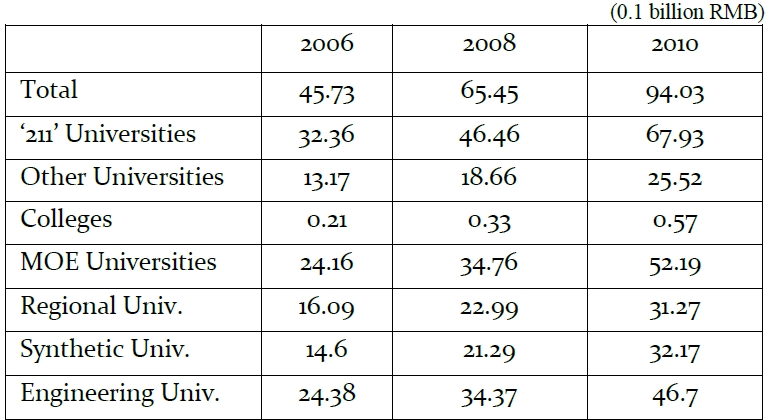
Research Funds from Industries
Table 1 provides information about funds from industries. Funds from industries increased sharply from 1.8 billion RMB in 2006 to 3.2 billion RMB in 2010, but the percentage share from industry is decreasing. The reason for this is because of huge increases from other sources.
Collaborative R&D centers between regional higher education bodies and industrial firms are shown on Figure 6. It seems such kind of joint R&D centers with companies are still infant in Chinese universities, compared with their own research bodies. It is interesting to note that collaboration with overseas companies is playing an important role, although it is limited. For instance, in 2010, among all university R&D centers, less than 10% of the centers set up collaborative relationships with domestic companies and only 0.5% R&D institutions are organized with foreign companies.
Figure 7 shows university-industry R&D collaboration by technology area. Medical and pharmaceuticals are the condensed fields, followed by mechanical and other typical engineering fields such as transportation, construction, and mining. Electronic and telecommunications, together with chemical & environmental S&T are in third. In general, we can conclude that medical & pharmaceutical, mechanical, electronic & telecommunications, and agriculture are important areas for university-industry collaborations in China in recent years.
3.3 University-Run High Tech Companies
The third effective way for universities to work with industries is to directly operate on industrial production based on universities’ own intellectual property or technology resources through university-run business companies. This is clearly shown from university-run business firms in high-tech zones in different regions in China.
Table 2 shows that although university-run high-tech firms are smaller in numbers, compared to all companies in high-tech zones, their assets and operations are generally dominative. On an economic return investment basis, university-run business companies generally out-perform non-university companies. Innovation indicators of these companies are also significantly higher than other firms in the high-tech zones. Therefore, university-run high-tech companies are usually key forces for regional and national innovation progress in China.
[Table 2] University-Run High-Tech Firms in National Development Zones

University-Run High-Tech Firms in National Development Zones
Another important nature of university-run high-tech firms is that the concentration rate of a few companies is quite high. For example, among top 100 university-run high tech companies, the top 10 companies own 84% of total assets, so only the top 14 companies are above the average size asset. (1.595 billion RMB) In total revenue, concentration is even higher; the top 10 firms control 94% of total revenues by nation-wide university-run companies. Again, only 7 companies are above the average level. (2.472 billion RMB)
1) The 211 scheme, named after 21 (the 21st century) and 1 (100 universities in China), was initiated in 1993 and aimed at well developing advanced universities in 21st century through continual effort by Chinese government. The “985” scheme was initiated in May 1998 by Chinese government to well promote internationally advanced universities, firstly in 34 and later on extended to additional 4 selected universities all over China.
4. University-Industry Collaboration in China: Joint-Patenting Movement and Its Nature
We further analyzed the collaborative patenting movement between universities and industrial companies.
Joint patenting is an important phenomenon for both innovation studies and entrepreneurial university studies because this movement reflects crucial demand from both sides for knowledge generation. It is especially important because from the university side, it is clearly an entrepreneurial intention to come closer to market demand for advanced technologies, and from the industrial side, the involved companies are very keen on technology-based competition in a specific market.
The patterns of the joint patenting movement in China can be contrasted in Figure 8. We can see clearly that inter-firm joint application is higher than inter-university joint applications. The joint patenting between universities and business firms was the lowest compared to inter-firm and inter-university groups. In Figure 8, continued drops during recent years have been due to time lag between applications and disclosues in the patenting system. Therefore, the decrease on each pattern is purely a matter of administration within the patent office. Hence, there is a clear trend for each of the three joint-patenting patterns, including the one between university and industries.
The joint patenting between universities and between firms are contrasted with joint patenting between university and firms in Figure 8. Although absolute terms of joint-patenting intra-firms is higher than between firmsuniversities, the ratio of intra-firm joint-patents to all patents of firms is lower than the ratio of intra-university joint-patents to all university patents.
[Table 3] University-Industry Collaborative Patenting by Technology Fields

University-Industry Collaborative Patenting by Technology Fields
4.2 Types of Co-patenting in Universities
We analyzed co-patenting between universities and industry by university type. 200 sample universities that had more than 100 patents between 1985 and 2010 were selected. Among them, 79 sample universities were addtionally selected, and their co-patents accounted for 51.8% of total patents from the 200 sample universities.
Figure 10 shows 4 types of patenting activities: The first type is high share of patenting and low rate of co-patenting or simply high share - low co-patenting, such as Zhejiang University and Shanghai Jiotong University. The second type is low share - low co-patenting universities. Third type is low share - high co-patenting.
This type is mostly shown at the professional universities, or in other words, special universities with industrial specialties, such as China Petrol University, China Forest University, etc. In the fourth type with high share and high co-patenting, there is only one university, Tsinghua. In addition to this typology, it is noteworthy that Tsinghua University and Peking University show high rate of co-patenting which may reflect their brand status.
4.3 Fields of Co-patenting between University and Industry
We include another analysis about university-industry co-patenting by technology fields from the IPC (Intetnational Patent Classification) sub-class using 1,913 co-patenting data as shown in Table 3. The IPC sub-classes on the table show more than 10 co-patenting types. The table shows that the technology span of co-patenting has become increasingly wider during the 8 years after 2000, and the speed of widening is remarkable.
G01N and A61K are the highest and second highest fields for co-patenting between the university and industry during 2000-2007, and the next is B01D. H04L and C07C are also frequent fields for co-patenting.2)
If we see the bigger classification, most frequent collaborative technical fields between university and industry are typically pharmaceutical, chemical, and electronic & telecommunications, which strongly implies that the university plays an important role in innovation for advanced industrial sectors as well as frontier technology.
2) Each IPC subclass indicates the technology field as follows. G01N: Investgating or anlaysing materials by determining their chemical or physical properties; A61: Preparation for medical, dental, or toilet purposes; B01D: Separation; H04L: Transmission of digital information; C07C: Acyclic or carbocyclic compounds.
This paper reviews the patterns of university industry collaboration in China by three paths: technology transfer, collaborative R&D, and university-run companies. And we added the analysis of co-patenting between university and industry. The patterns in university industry collaboration are summarized as follows:
a) Although the speed of growth of university patenting during the second half of 2000 was very fast, it is a little slower than the growth speed of university licencing.
b) The speed of revenue growth is faster than the speed of contract growth. That means each contract is worth more.
c) About 100 good universities or the so-called 211 universities accounts for 42% of total technology transfers by all univesities.
d) Technology transfer to private-owened companies has increased very fast and surpassed the number of technology transfer to public-owned companies from 2009.
e) University-run companies in the national high-tech development zone dominates the zone; in 2009, they had 84.8% of total assets and 88.5% of revenues.
f) Top 10 university-run companies recorded shares of 94% of total revenues, and 84% of total assets from the top 100 university-run companies. The concetration ratio to a few universities is noteworthy.
The patterns in co-patenting are as follows:
a) Every type of co-patenting such as “between university and industry”, “between firms” and “between universities” has increased sharply since 2000.
b) Although co-patenting “between university and industry” is lower than co-patenting “between firms” and co-patenting “between universities”, the share of co-patenting of universities among all universitity patenting is higher than that of industry patenting.
c) Universities having industry specialties are in the low share - high co-patenting type such as China University of Petroleum, CAST Pharmacy Institute, Beijing Forest University, and Wenzhou Medical Universities.
d) Technology span of co-patenting has become increasingly wider during these 8 years since 2000, and the speed of widening is remarkable.
e) G01N and A61K are the highest and second highest fields for co-patenting between university and industry during 2000-2007, and the next field is B01D. H04L and C07C are also frequent fields for co-patenting.
f) Pharmaceutical, chemical, and electronic & telecommunications are the typical fields for co-patenting.
This paper is an analysis of university industry collaboration based on patents. Also, this paper is an analysis of statistics, so further analysis on case studies or a conceptual framework for the university industry colaboration will have to be conducted.
